In the Cards, Part 1
It's time for me to go card by card and talk about a lot of the design decisions that went into making the new cards in Core Set 2019. Let's get started!
Aethershield Artificer
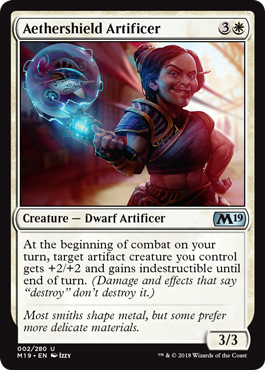
As I talked about last week, there are numerous advantages to a core set, and one of those is the ability to represent a wide variety of Magic planes. One of the cool things this lets you do is design cards for sets long-since printed. Take Aethershield Artificer as an example. This is basically a Kaladesh card that didn't come out in Kaladesh block. The card was designed to go into the white-blue archetype in the set, which cares about artifacts. If you draft this card early, it pushes you to care a little more about artifact creatures and cards that can produce artifact creature tokens. This isn't a major theme in the set like it was in Kaladesh, but it's something showing up in white and blue.
Obviously, the card can also slide into any Constructed deck that cares about artifact creatures (or Vehicles, as they become artifact creatures). The card was made a Dwarf Artificer to match the Kaladesh feel, as that was the race of mechanics in Kaladesh. This little peek at the known planes around the Multiverse gives the core set a very different feel from normal sets.
Ajani, Adversary of Tyrants
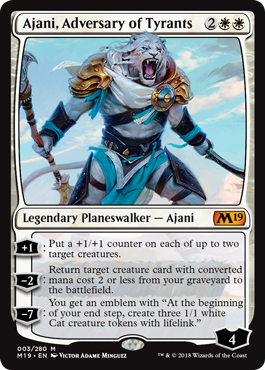
Core Set 2019 has a slightly different flavor than most sets. Instead of focusing on the current story, it's taking a peek into the past and helping us understand the origin of Nicol Bolas. To do this, each of the planeswalkers in Core Set 2019 are set in the past at a time when the character interacted with Bolas. Ajani's card comes from the Shards of Alara storyline, the one time he fought Bolas directly.
One of the major goals when designing a Planeswalker character is to stay true to the essence of their character while making a card that will be fun to play. Ajani's magic is usually tied to him interacting with others. He's good at recruiting, buffing, and healing allies. His magic is never about helping himself but rather helping his teammates.
The first ability is a buffing one, and it requires him ideally having two creatures to buff. It says "up to two" in case you have one or zero creatures and still want to gain loyalty. Almost every Ajani planeswalker card has had a buffing ability. The second ability is a way for him to recruit more creatures to fight with you using a white ability that he's never used before. The flavor isn't resurrection, just that he's getting another ally similar to one he already had. The limit to the smaller size is because that's the limitation in white for reanimation.
His ultimate is made to be easier to get and gives you an emblem that won't win right away but will help you build up over time to swarm your opponent. The creatures are 1/1 Cat creatures with lifelink because I believe it's trying to show him gathering more of his kind. This token, which I'm guessing was set to match the favor of Ajani, shows up elsewhere in Core Set 2019 as one of the main tokens in the set. The reason the emblem triggers at the end of the turn rather than at the beginning of the turn is to allow you to gain a benefit the turn you use the ultimate. It already takes a while to reach the ultimate, so we didn't want to make the player have to wait yet another turn to start reaping the benefits.
The Elder Dragons

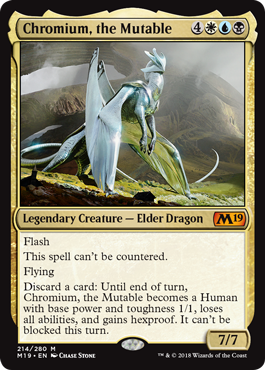
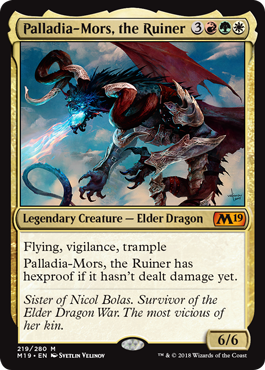
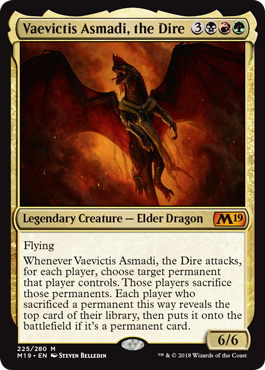
We're going into Nicol Bolas's past in this set, so that means we're going back to where it all started for Bolas (well, game-wise), the Elder Dragons (and yes, these were the guys that first inspired the Commander format). Nicol Bolas first premiered in Legends in the summer of 1994 (the Phyrexians premiered the set before in Antiquities, edging out Nicol Bolas as Magic's oldest returning villain; if Mishra ever came back from the dead, he could break the record) as part of a cycle of three-color Dragons. Once we knew Core Set 2019 was going to be about Bolas, the Elder Dragons were penciled in for a return.
Nicol Bolas gets his own special card, but I'm going to talk about that one separately later. For now, let's discuss the other Elder Dragons of lore. First is Arcades, the Strategist. Arcades is the cautious, tactical one. He has flying because he's a Dragon and vigilance to play up his cautious nature. His two abilities are both "defender matters" effects. The first rewards you for playing creatures with defender by letting you draw cards, and the second allows the defenders to not only attack but use their toughness, which traditionally is higher than the power. We haven't made a "defenders can attack" card in a while, and we liked the idea that this deck has you play defensively until Arcades shows up and turns that defense into offense. Quite strategic.
Chromium's mechanic plays into the abilities the character had in the stories to turn into a Human. The trick was how do you make turning from a Dragon into a Human a fun thing? Usually players want to go the opposite direction from a small creature into a large creature. The design tackled this in two ways. One, the card was made to be a cool Dragon on its own. It's a 7/7 flier for seven mana, has flash, and "can't be countered," allowing you to surprise the opponent in a way that can't be prevented. Then, the Human-changing ability granted two things: one, unblockability to allow you to get in the last few points of damage on a stalled board, and two, hexproof to allow you to respond to a destruction spell. The ability costs no mana, only a discarded card, so it's hard to catch Chromium unaware.
Palladia-Mors was the most ruthless and best raw attacker, so the design was made to match that. All of her abilities are creature abilities. She doesn't do anything other than be a good attacker. The flying and trample help her get through while the vigilance also allows her to act defensively while still doing damage each turn. I believe the card started with hexproof, but that proved to be a little too rough, so it was tweaked to protect Palladia-Mors up until the point that she starts doing damage.
Vaevictis Asmadi is the most chaotic, so Vaevictis was given an ability that replicates one of the more chaotic mechanics in the game. When he attacks, he gets to force every other player (this was designed to work well in a multiplayer game, as they all were—they are Elder Dragons after all) to basically polymorph a permanent into another permanent some of the time; players can sometimes miss hitting a replacement and just lose their permanent.
The goal of each of these designs was to play well in formats like Commander and Brawl while also being fun cads for the Vorthoses to include in their history/story-themed decks.
Departed Deckhand
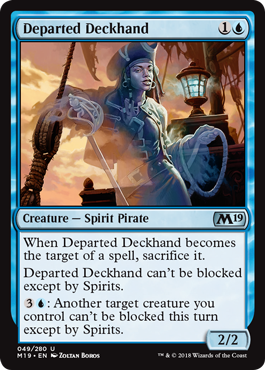
One of the things we get to do with the core set is provide more support cards for sets in Standard such as Ixalan. Merfolk and Vampires are pretty normal for Magic, so those aren't hard to squeeze in the set. We found ways to get in a few Dinosaurs. Departed Deckhand is the one Pirate in the set, and I think it's a very clever design.
This card started, I believe, with the top-down concept of a Pirate ghost. The idea of dead spirits of Pirates hanging around shows up throughout Pirate stories, so it seemed like a fun top-down to explore. So how do you make a Pirate Spirit? For starters, it can get some form of unblockability. Taking a cue from the shadow mechanic (all the way back in Tempest), R&D made it unblockable by everything but Spirits. Then it was given an activated ability to allow it to affect other creatures and grant them the same type of unblockability.
Finally, as a means to make the card have a better mana-cost-to-card-effect ratio, R&D decided to give it a drawback. What blue drawback would flavorfully fit a Spirit? How about the Illusion drawback? That's the "when this creature becomes the target of a spell, sacrifice it" text that originally started on black ghosts (originally on Mirage's Skulking Ghost), which we later moved over to blue Illusions. As soon as someone notices it enough to cast a spell, it melts away due to its incorporeality. Put it all together and you have a cool top-down design.
Diamond Mare
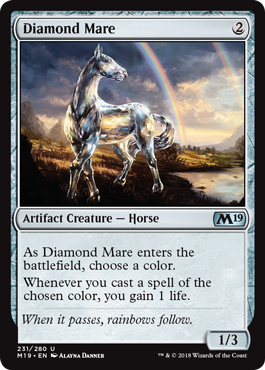
In Limited Edition (Alpha), there was the following cycle of uncommon artifacts:
Each one allowed you to pay one whenever anyone cast a certain color spell to gain 1 life. The cycle was nicknamed "lucky charms" (I'm not sure why). The cards proved to be relatively weak (although, a few did show up in early World Championship Top 8 decks) but were very popular with the casual crowd. So much so, they were in most of the core sets up until Eighth Edition.
Antiquities added a version that cared about artifacts.
In Mercadian Masques, we tried out a replacement for the lucky charms.
This artifact costs one more, but it let you select whatever color you wanted. It then charged you two mana to use but gained you 2 life. The thought behind this card was if players liked it, then we could replace five core set cards with just one card, but the experiment didn't go well. Between the extra costs and the lack of strong flavor, players didn't take to Jeweled Torque.
In Ninth Edition, we decided it was finally time to clean them up, and we made this cycle, nicknamed "the new lucky charms":
They cost one more but no longer required you to pay to gain the life. Our goal was to tie this cycle flavorfully to the iconic creature of each color, but blue and green where still hunting for their proper iconic (Sphinx and Hydra were years away). These new lucky charms went into the core set, where they stayed until Magic 2012.
Scars of Mirrodin would later add the artifact member of this cycle:
Time Spiral tried out a new lucky charm in the vein of Jeweled Torque:
Paradise Plume combined an artifact that tapped for any color mana along with a lucky charm based on a color you chose when you cast Paradise Plume.
Which brings us to Diamond Mare, the newest take on the lucky charms. Diamond Mare tries the "one card rather than a cycle" approach by letting you choose the color when you cast it. Then, to give it a little extra utility, it for the first time makes a lucky charms creature. I'm curious to see what the players think of this take on the concept.
Gigantosaurus
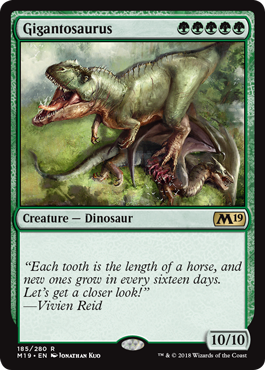
I'm going to start with a trivia question. How many cards with a converted mana cost of 5 have nothing but colored mana symbols in their casting costs?
Click to reveal the answer
The answer is 28. There are sixteen cards that have a mana cost of WUBRG (Atogatog, Child of Alara, Chromanticore, Cromat, Fusion Elemental, Genju of the Realm, Horde of Notions, Last Stand, Maelstrom Archangel, Maelstrom Nexus, Scion of the Ur-Dragon, Sliver Hivelord, Sliver Legion, Sliver Overlord, Sliver Queen, and Urza, Academy Headmaster), ten cards with five hybrid mana (Deity of Scars, Demigod of Revenge, Deus of Calamity, Divinity of Pride, Dominus of Fealty, Ghastlord of Fugue, Godhead of Awe, Nobilis of War, Overbeing of Myth, and Oversoul of Dusk), and only one that has a mana cost of single color (Rushwood Elemental from Mercadian Masques), bringing the total to 27 prior to Core Set 2019. Gigantosaurus is the newest member of this list and the second mono-green one.
I believe this card was created to be the largest Dinosaur possible for five mana.
Goreclaw, Terror of Qal Sisma

One of the side effects of being a spokesperson for the game, especially one with a blog where anyone can easily write to me, is I get a lot of requests. One popular type of request is for legendary cards for creature types that have never had a legendary card. For quite a while now, the creature type that gets requested the most often is legendary Bear. I have mentioned that I regret I didn't realize the Bear theme that ended up in Khans of Tarkir, as it would have been the perfect place for a legendary Bear. I'm happy to say that, finally, a legendary Bear has made it to print. Interestingly rather than a Bear lord, Goreclaw is more of a build-around for big creatures. It allows you to play bigger creatures for less mana and pumps them when Goreclaw attacks. I hope many of you who have wanted a Bear Commander can have some fun with Goreclaw.
Hungering Hydra
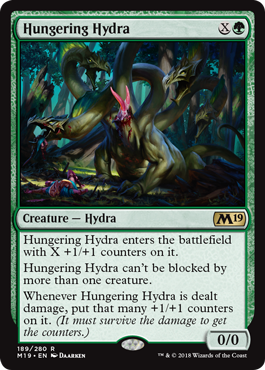
As a Magic card designer, one of my favorite things is to find ways to take preexisting abilities and combine them in ways that create a brand-new card. Hungering Hydra is a perfect example. The card has three abilities. The first is the basic Hydra ability: pay X when you cast it and it enters the battlefield with X +1/+1 counters. This ability has appeared on numerous other creatures, but has become a pretty standard ability for Hydras.
The second ability is what we in R&D call "stalking." It first appeared on Stalking Tiger in Mirage and has been a staple ability in green, usually going on larger green creatures. The third ability is a tweak on an ability first seen in Alpha on a creature named Fungusaur. Fungusaur just got one counter per each batch of damage, but Hungering Hydra gets a counter for each point of damage dealt to it.
Each of these abilities has shown up in some form in green, but never before have they all been put together. What we get is a cool synergy where the Hydra grows as it's damaged and its stalking ability makes it hard for the opponent to do anything other than chump block it, ensuring it continues to grow and grow.
Infernal Reckoning

One of the tasks of Core Set 2019 was to make some cards relevant in Modern but not disruptive to Standard. This is tricky because the things that tend to make cards stand out in a format many times larger than Standard tend to be pretty good in Standard. The trick was to find areas that mattered in Modern that weren't as relevant in Standard. Also, just to make the task extra-difficult, the card has to seem to fit in the set it appears in. It doesn't have to be a perfect fit, but it can't feel totally out of place.
Infernal Reckoning is a good example of a card that manages to hit all these goals. First, how do we make it relevant in Modern? Find a problem Modern has and try to solve it. How about the Eldrazi, especially the large legendary ones? They are often difficult to kill and even when you do kill them, they get shuffled back into your library to be drawn again later. Is there a cheap way to deal with the Eldrazi that isn't going to create splash damage in Standard?
Let's focus on a quality of Eldrazi that's somewhat unique—their colorlessness. Now Standard has colorless creatures (artifact creatures), but usually we don't make too many of them in Standard-legal sets. The most recent big set to have lots of artifact creatures was Kaladesh, a set close to rotating out. By exiling the creature, it allows us to answer one of the biggest issues with Eldrazi—the fact that they keep coming back. Also, the card has a life rider which is more potent the bigger the creature is. This means that the spell has some functionality in Standard but has qualities that address a Modern issue.
Just in case players didn't get that this card was made to help deal with Eldrazi in Modern, the Creative team helped out by creating art and flavor text that hammers this point home.
Halfway There
We've run out of time for today, but I have more cards to talk about, so we'll have to continue this next week. As always, I'm eager to hear your feedback on today's column, any of the cards I've talked about today, or Core Set 2019 in general. You can write me an email or contact me through any of my social media accounts (Twitter, Tumblr, Google+, and Instagram).
Join me next week for part two.
Until then, may you have as much fun playing Core Set 2019 as we had making it.
#547: Jumping-Off Points
#547: Jumping-Off Points
For this podcast, I walk through every design team I've led or co-led and talk about what the jumping-off point was for the design to show the many different paths we start with when making a set.
#548: Kicker
#548: Kicker
38:39
In this podcast, I talk about the history of the kicker mechanic from its start in Invasion all the way through to its use in Dominaria.
- Episode 546 World Identities
- Episode 545 20 Lessons – Feedback
- Episode 544 GDS3 Check-In

